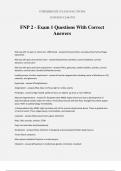©THEBRIGHT EXAM SOLUTIONS
11/05/2024 12:06 PM
FNP 2 - Exam 1 Questions With Correct
Answers
Red eye with no pain or vision loss- differential - answer✔Conjunctivitis, sunconjunctival hemorrhage;
episcleritis
Red eye with pain and normal vision - answer✔episcleritis, keratitits, cluster headache, corneal
abrasion, corneal ulcre
Red eye with pain and vision impairment - answer✔iritis, glaucoma, orbital cellulitis, scleritis, corneal
abrasion, corneal ulcer, keratitis (inflamed cornea)
Leading causes of vision impairment - answer✔macular degeneration (leading cause of blindness in US),
cataracts, and glaucoma
Hyperopia - answer✔farsightedness
Astigmatism - answer✔Eye does not focus light on retina evenly
Presbopia - answer✔age related, ability to focus on objects up close is more difficult
Macular Degeneration - answer✔○ Exudative (wet AMD): Rapid vision loss due to development of
abnormal blood vessels under the retina. These blood vessels will leak fluid. Straight lines often appear
wavy. Refer to opthamology immediately.
○ Nonexudative (dry AMD): Light-sensitive cells of the macula slowly break down. There is gradual loss
of central vision. Three stages (early, intermediate, and advanced).
Cataracts - answer✔decreased vision, glare, distortion
Risks: DM, steroids, smoker, ETOH
Pupil can had white look (leukokoria)
Hordeolum - answer✔Stye; infection of oil glands around eyelash follicle; Staph Aureus
Treat: Warm compress
May require antibiotic Polytrim or erythromycin
Chalazion - answer✔Develop inn meibomian glands; nontender, localized
, ©THEBRIGHT EXAM SOLUTIONS
11/05/2024 12:06 PM
Blepharitis - answer✔Inflamation of eyelid margins; staph infection
Keratitis - answer✔Infection or irritation of cornea; eye pain, photophobia, cloudy cornea, If non-
infectious, eye patch and lubrication
Corneal abrasion - answer✔Use fluroescein staining
Flashes - answer✔Photopsia
Floaters - answer✔Entopsia
Periorbital Cellultis - answer✔○ Chandlar staging system
§ Stage I: Periorbital cellulitis
§ Stage II: Inflammatory orbital edema
§ Stage III: Subperiosteal abscess
§ Stage IV: Orbital abscess
Pingueculum - answer✔Common, non-cancerous growth of the conjunctiva, yellowish nodule, usually
nasal side, confined to bulbar of conjunctiva
Pterygium - answer✔Non-cancerous growth of conjunctiva that extends into cornea
Retinal detachment - answer✔nuerosensory retina is separated from retinal pigment epithelium;
floaters, flashes, and peripheral visiona loss, curtain going down
Closed Angle Glaucoma - answer✔Asian, unilateral headached, visual blurring, photophobia N/V,
emergency
Open Angle Glaucoma - answer✔Abnormality in trabecular angle tissue causing resistance to flow; slow
and insidious; loss of PERIPHERAL
Episcleritis - answer✔Inflammation of the covering of the sclera
What can a child see? - answer✔○ Birth-2 weeks: changes in illumination, contrasts (20/400); keep eyes
closed often; tears not present 1-3 months
○ 2-4 weeks: can fix and follow an object (20/400)
○ 3-4 months: recognizes parent's smile,can focus near/far, follow 180 arc (20/200)
○ 4 months: color vision similar to adult (20/200)
○ 6-10 months: smooth eye movements in all directions (20/150)
○ 12 months: vision close to fully developed (20/50)
, ©THEBRIGHT EXAM SOLUTIONS
11/05/2024 12:06 PM
○ 18 months-24 months: (20/25)
○ 5 years: (20/25 to 20/20)
Corneal light reflex test - answer✔eye muscle balance issue; Hirschberg Reflex; shine on both eyes- is
light reflection symmetric? Evaluation for strabismus
Conjunctivitis - answer✔Acute purulent conjunctivitis:Conjunctival hyperemia, edema, mucopurulent
exudate. Usually bacterial.
§ Bacterial - Erythromycin ointment - in neonates
§ Oxaflaxicin - for 1 year + (make sure to treat both eyes even if one is currently infected)
Strabismus - answer✔Corneal light and cover uncover
Esotropia- inward is most common
Treatment with patching of good eye- referred to peds
Amblyopia - answer✔Secondary vision loss because brain cannot focus on two visual fields
Acute Otitis Media Prevention - answer✔• Pneumococcal vaccine
• Yearly influenza vaccine
• Breastfeeding exclusively until at least 6 months old
• Avoiding tobacco exposure
Tinnittus- what to do? - answer✔• Stop ototoxic meds.
• Decrease noise exposure.
• Decrease caffeine and nicotine use.
Treat the cause.
Labyrinthitis - answer✔Vertigo, nausea, and vomiting, aggravated by head movements; can occur after a
URI; spontaneous nystagmus
Labyrinthitis Management - answer✔• Bed rest.
○ Side lying position with affected ear uppermost.
○ Increase activity as tolerated.
• Meclizine 12.5-50 mg every 6 hours.
• Sedatives, antiemetics PRN.




